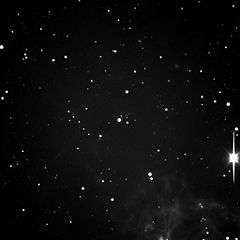17 Thetis
 Star field showing asteroid Thetis in the center | |
| Discovery [1] | |
|---|---|
| Discovered by | R. Luther |
| Discovery site | Düsseldorf-Bilk Obs. |
| Discovery date | 17 April 1852 |
| Designations | |
| MPC designation | (17) Thetis |
| Pronunciation | /ˈθiːtɪs/ (THEE-tis) |
Named after | Thetis (Greek mythology)[2] |
|
1954 SO1 · A913 CA A916 YF | |
| main-belt [3] · (inner) | |
| Adjectives | Thetidian |
| Orbital characteristics [1] | |
| Epoch 16 February 2017 (JD 2457800.5) | |
| Uncertainty parameter 0 | |
| Observation arc | 164.55 yr (60,102 days) |
| Aphelion | 2.7987 AU |
| Perihelion | 2.1436 AU |
| 2.4712 AU | |
| Eccentricity | 0.1325 |
| 3.88 yr (1,419 days) | |
Average orbital speed | 18.87 km/s |
| 100.44° | |
| 0° 15m 13.32s / day | |
| Inclination | 5.5902° |
| 125.56° | |
| 136.10° | |
| Physical characteristics | |
| Dimensions |
84.899±2.027[4] 90±3.7km (IRAS)[5] 93.335±2.627[6] |
| Mass | 1.2×1018 kg[7][lower-alpha 1] |
Mean density | 3.21±0.92 g/cm³[7] |
| 12.27048±0.00001[8][9] | |
| 0.193±0.028[4] | |
|
B–V = 0.829[1] U–B = 0.438[1] S (Tholen)[1] Sl (SMASS)[1] · S [8] | |
| 7.76[1][5][6] · 7.85[9] | |
|
| |
17 Thetis (THEE-tis), provisional designation A913 CA, is a stony asteroid from the inner regions of the asteroid belt, approximately 90 kilometers in diameter. It was discovered on 17 April 1852, by German astronomer Robert Luther at Bilk Observatory in Düsseldorf, Germany.[3] He named his first asteroid discovery after Thetis from Greek mythology.[2]
Description
The asteroid orbits the Sun at a distance of 2.1–2.8 AU once every 3 years and 11 months (1,419 days). Its orbit has an eccentricity of 0.13 and an inclination of 6° with respect to the ecliptic.[1]
The spectrum of this object indicates that it is an S-type asteroid with both low and high calcium forms of pyroxene on the surface, along with less than 20% olivine. The high-calcium form of pyroxene forms 40% or more of the total pyroxene present, indicating a history of igneous rock deposits. This suggests that the asteroid underwent differentiation by melting, creating a surface of basalt rock.[10]
The mass of Thetis has been calculated from perturbations by 4 Vesta and 11 Parthenope. In 2007, Baer and Chesley calculated Thetis to have a mass of 1.2×1018 kg[lower-alpha 1] with a density of 3.21 g/cm³.[7]
One Thetidian stellar occultation was observed from Oregon in 1999. However, the event was not timed.
This minor planet was named after Thetis, the mother of Achilles in Greek mythology.[2]
Notes
- 1 2 Thetismass2007: Mass of Thetis 0.00617 / Mass of Ceres 4.75) * Mass of Ceres 9.43E+20 = 1.224E+18, based on Baer 2008[7]
References
- 1 2 3 4 5 6 7 8 "JPL Small-Body Database Browser: 17 Thetis" (2016-11-11 last obs.). Jet Propulsion Laboratory. Retrieved 24 March 2017.
- 1 2 3 Schmadel, Lutz D. (2007). Dictionary of Minor Planet Names – (17) Thetis. Springer Berlin Heidelberg. p. 17. ISBN 978-3-540-00238-3. Retrieved 24 March 2017.
- 1 2 "17 Thetis". Minor Planet Center. Retrieved 24 March 2017.
- 1 2 Masiero, Joseph R.; Grav, T.; Mainzer, A. K.; Nugent, C. R.; Bauer, J. M.; Stevenson, R.; et al. (August 2014). "Main-belt Asteroids with WISE/NEOWISE: Near-infrared Albedos". The Astrophysical Journal. 791 (2): 11. arXiv:1406.6645. Bibcode:2014ApJ...791..121M. doi:10.1088/0004-637X/791/2/121. Retrieved 24 March 2017.
- 1 2 Tedesco, E. F.; Noah, P. V.; Noah, M.; Price, S. D. (October 2004). "IRAS Minor Planet Survey V6.0". NASA Planetary Data System. Bibcode:2004PDSS...12.....T. Retrieved 24 March 2017.
- 1 2 Mainzer, A.; Grav, T.; Masiero, J.; Hand, E.; Bauer, J.; Tholen, D.; et al. (November 2011). "NEOWISE Studies of Spectrophotometrically Classified Asteroids: Preliminary Results" (PDF). The Astrophysical Journal. 741 (2): 25. arXiv:1109.6407. Bibcode:2011ApJ...741...90M. doi:10.1088/0004-637X/741/2/90. Retrieved 24 March 2017.
- 1 2 3 4 Baer, James; Chesley, Steven R. (January 2008). "Astrometric masses of 21 asteroids, and an integrated asteroid ephemeris" (PDF). Celestial Mechanics and Dynamical Astronomy. 100 (1): 27–42. Bibcode:2008CeMDA.100...27B. doi:10.1007/s10569-007-9103-8. Retrieved 24 March 2017.
- 1 2 "LCDB Data for (17) Thetis". Asteroid Lightcurve Database (LCDB). Retrieved 24 March 2017.
- 1 2 Michalowski, T.; Velichko, F. P.; Di Martino, M.; Krugly, Yu. N.; Kalashnikov, V. G.; Shevchenko, V. G.; et al. (December 1995). "Models of four asteroids: 17 Thetis, 52 Europa, 532 Herculina, and 704 Interamnia". Icarus. 118 (2): 292–301. Bibcode:1995Icar..118..292M. doi:10.1006/icar.1995.1192. Retrieved 24 March 2017.
- ↑ Sunshine, Jessica M.; Bus, Schelte J.; McCoy, Timothy J.; Burbine, Thomas H.; Corrigan, Catherine M.; Binzel, Richard P. (August 2004). "High-calcium pyroxene as an indicator of igneous differentiation in asteroids and meteorites". Meteoritics and Planetary Science. 39 (8): 1343–1357. Bibcode:2004M&PS...39.1343S. doi:10.1111/j.1945-5100.2004.tb00950.x. Retrieved 24 March 2017.
External links
| Wikimedia Commons has media related to 17 Thetis. |
- 2011-Apr-22 Occultation (Durech Model) / (2011 Asteroidal Occultation Results for North America)
- Asteroid Lightcurve Database (LCDB), query form (info)
- Dictionary of Minor Planet Names, Google books
- Asteroids and comets rotation curves – (17) Thetis at Observatoire de Genève, Raoul Behrend
- Discovery Circumstances: Numbered Minor Planets (1)-(5000) – Minor Planet Center
- 17 Thetis at AstDyS-2, Asteroids—Dynamic Site
- 17 Thetis at the JPL Small-Body Database
